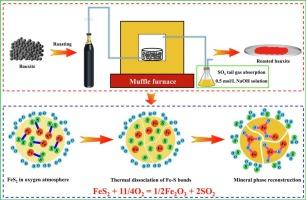不同添加剂对高硫铝土矿焙烧脱硫的影响:相变和微观形态演变
IF 4.6
2区 工程技术
Q2 ENGINEERING, CHEMICAL
引用次数: 0
摘要
铝土矿的高硫含量对氧化铝生产提出了重大挑战。本研究探讨了氧化焙烧作为一种脱硫策略,考察了焙烧温度、持续时间和各种添加剂对脱硫的影响。结果表明,在600℃无添加剂条件下,焙烧铝土矿中硫的质量分数由16.63%降至0.27%,硫的去除率为98.75%。O2的加入提高了脱硫效率。在500℃、1.2 g/min、120 min条件下,硫含量降至0.66%,去除率为96.83%,比无氧条件下提高了26.53%。然而,当引入NaNO3和Na2O2时,Na2SO3、NaFeS2和Na2SO4的形成显著抑制了硫的释放。利用各种现代分析技术,研究了焙烧前后铝土矿的矿物学特征、相变、化学成分和微观结构演变。结果表明:黄铁矿作为原生含硫相,分解为Fe2O3和SO2;值得注意的是,无添加剂和o2辅助焙烧均提高了铝土矿的表面粗糙度、孔隙率和裂纹形成,从而提高了铝土矿的溶出性能。本文章由计算机程序翻译,如有差异,请以英文原文为准。

Desulfurization of high‑sulfur bauxite through roasting with various additives: phase transformation and micromorphological evolution
The high‑sulfur content of bauxite presents a significant challenge in alumina production. This study explored oxidative roasting as a desulfurization strategy, examining the effects of roasting temperature, duration, and various additives on sulfur removal. The results indicated that under conditions of 600 °C for 120 min without additives, the sulfur mass fraction in the roasted bauxite decreased from 16.63 % to 0.27 %, achieving a sulfur removal rate of 98.75 %. The addition of O2 enhanced desulfurization efficiency. At 500 °C for 120 min with an O2 flow rate of 1.2 g/min, sulfur content decreased to 0.66 %, corresponding to a 96.83 % removal rate, which was 26.53 % higher compared with that achieved without O2 assistance. However, when NaNO3 and Na2O2 were introduced, the formation of Na2SO3, NaFeS2, and Na2SO4 significantly suppressed sulfur release. Furthermore, upon using various modern analytical techniques, the study investigated mineralogical characteristics, phase transformations, chemical composition, and microstructural evolution of bauxite before and after roasting. Results indicated that pyrite, the primary sulfur-bearing phase, decomposed to Fe2O3 and SO2. Notably, both additive-free and O2-assisted roasting increased surface roughness, porosity, and crack formation of the bauxite, which enhanced its digestion performance.
求助全文
通过发布文献求助,成功后即可免费获取论文全文。
去求助
来源期刊

Powder Technology
工程技术-工程:化工
CiteScore
9.90
自引率
15.40%
发文量
1047
审稿时长
46 days
期刊介绍:
Powder Technology is an International Journal on the Science and Technology of Wet and Dry Particulate Systems. Powder Technology publishes papers on all aspects of the formation of particles and their characterisation and on the study of systems containing particulate solids. No limitation is imposed on the size of the particles, which may range from nanometre scale, as in pigments or aerosols, to that of mined or quarried materials. The following list of topics is not intended to be comprehensive, but rather to indicate typical subjects which fall within the scope of the journal's interests:
Formation and synthesis of particles by precipitation and other methods.
Modification of particles by agglomeration, coating, comminution and attrition.
Characterisation of the size, shape, surface area, pore structure and strength of particles and agglomerates (including the origins and effects of inter particle forces).
Packing, failure, flow and permeability of assemblies of particles.
Particle-particle interactions and suspension rheology.
Handling and processing operations such as slurry flow, fluidization, pneumatic conveying.
Interactions between particles and their environment, including delivery of particulate products to the body.
Applications of particle technology in production of pharmaceuticals, chemicals, foods, pigments, structural, and functional materials and in environmental and energy related matters.
For materials-oriented contributions we are looking for articles revealing the effect of particle/powder characteristics (size, morphology and composition, in that order) on material performance or functionality and, ideally, comparison to any industrial standard.
 求助内容:
求助内容: 应助结果提醒方式:
应助结果提醒方式:


